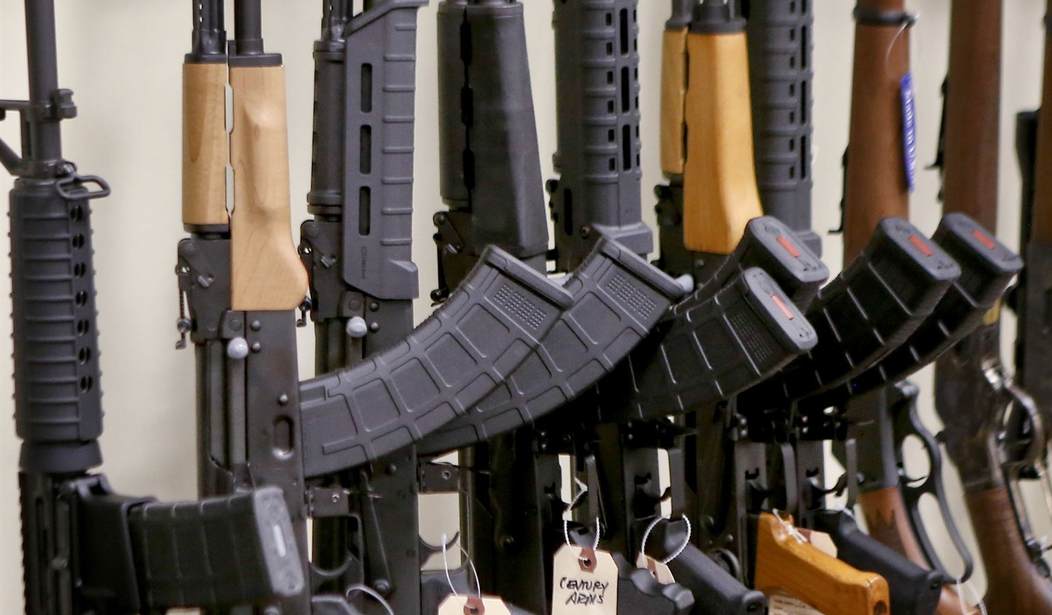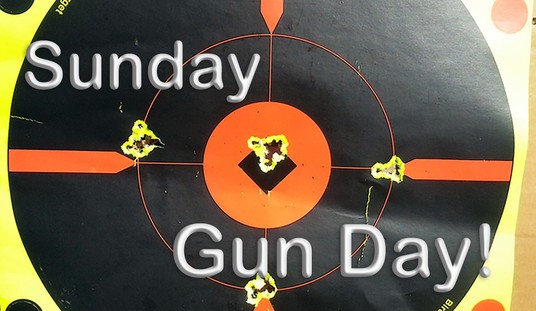Ward M. Clark is an author, lecturer, traveler, woods bum, and semi-professional bad influence.
There has been, understandably, a lot of talk about semi-auto firearms lately, and a lot of pixels have been spilled on the topic on both sides of the Second Amendment debate. Unsurprisingly, there are plenty of people on both sides getting a lot of basic things wrong. And in case anyone reading this is not familiar with firearms, I’ll state a definition of a semi-automatic firearm: A repeating firearm that, on firing, ejects the empty case and cycles the action to chamber a new round and cock the action for firing without any action on the part of the shooter, doing so one time for each trigger pull.
Before we start: I won’t waste any time debunking any of the ever-more-moronic hyperbole coming from the political Left on these weapons. That’s been done a million times already, and I need not repeat it. What I will do here is go into some of the history of semi-auto firearms, including handguns and shotguns but mostly rifles, as that is the ongoing debate today. I’ll talk about their function and about some of the more significant designs, including the famous AR-15 pattern rifles, and then I’ll talk a little about that debate and some of the misconceptions and just plain stupidity involved in it.
But first, some history.
The 19th Century
The first semi-auto firearms date back to the closing years of the nineteenth century. So, we don’t exactly have a brand-new thingamajig, here. Several famous names are involved here: Browning, Mauser, Borchardt, Mannlicher, and Maxim among them.
One of the very first was a rifle. In 1885, Ferdinand von Mannlicher brought out his Handmitrailleuse, a long, awkward arm firing the 11mm Austrian black-powder cartridge then in use. The Mannlicher arm didn’t blow up any skirts, as the heavy black powder round gunked up the action quickly; the arm never entered mass production. Nor did the weapon detailed in Hiram Maxim’s 1888 patent for a recoil-operated semi-auto rifle based on a heavily modified Winchester lever gun.
In the handgun world, though, the next few years saw a number of successes on both sides of the Atlantic. The very first semi-auto pistol appeared in 1891, that being the Austrian Salvator-Dormus pistol firing a proprietary 8mm round; this arm, however, didn’t go much of anywhere. There were a few others, including the Mannlicher Model 1894 and the Bergmann Model 1896. While none of those saw much commercial success, they were followed by a few notable pieces that proved more successful.
In 1894, a German named Hugo Borchardt introduced his Borchardt C-93 pistol, using a patented toggle-lock action. The C-93 wasn’t much of a much, but the toggle action was, later being adopted into the immortal P-08 Luger. Then, in 1896, the C96 Mauser “Broomhandle” pistol entered the market. This piece was designed by Mauser engineers Fidel, Friedrich, and Josef Feederle. This gun proved quite a commercial success, as it was adopted by several nations as a service pistol and was in production until 1961.
On the other side of the Atlantic, a Mormon gunsmith named John Browning, the Leonardo DaVinci of firearms, was tinkering with shotguns. His first attempts at a semi-auto shotgun yielded two prototypes (which you can see at the Browning Museum in Ogden, Utah) of a piece with a Luger-like toggle action, but patent concerns made him go in another direction, and in 1898, he finalized a design that would be patented in 1900 and enter production in 1905; this was the famous Browning Auto-5, and this piece would remain in production for over ninety years.
So, as the nineteenth century gave way to the twentieth, semi-auto arms were already well represented in both Europe and the Americas.
The 20th Century
Self-loading arms weren’t practical, though, until a breakthrough in propellants made them so, that being the advent of smokeless powders. Black powder, with its unfortunate property of producing plenty of thick fouling, isn’t conducive to reliable action in a self-loading arm, but once that problem was resolved, the production of semi-autos began to take off.
During the first half of the twentieth century, semi-auto shotguns began to appear in profusion. While the Browning Auto-5 was the first to reach mass market success, it soon had competition. Remington and Savage built the Auto-5 under license as the Remington Model 11 and the Savage 720, but the market soon saw such items as the Remington 11-48, a gas-operated shotgun, as opposed to the Browning long-recoil action. And in the handgun world, Colt largely led the way in the Americas, with a series of Browning designs capped by the great Model 1911, still in wide production by a variety of manufacturers now, well over a hundred years later. It’s surprising, when you look at it, how little there is in the gun world that’s really new.
But, in today’s gun debate, rifles seem to be the hot-button issue, and again, the semi-auto rifle is far from a recent development. The first American semi-auto rifle to enter mass production for commercial sale was the Winchester Model 1905, firing the proprietary Winchester Self-Loading rounds in .32, .35, and later the .351 and .401 versions. This arm set the standard layout for semi-automatic rifles, with a detachable box magazine in front of the trigger guard. So, in 1905, we had a rifle that functioned essentially the same way as a brand-new AR clone fresh off the gun dealer’s rack. Also in 1905, competitor Remington introduced their Remington Autoloading Rifle, later called the Model 8, another design of John Browning. The Remington had the advantage of firing more powerful rounds than the Winchester, with the proprietary .25, .30, .32, and .35 Remington rounds. The first three were rimless versions of the .25-35, .30-30, and .32 Winchester Special rounds, while the .35 Remington became a popular round in its own right and is still in use today. Later in the century, those companies would introduce semi-auto rifles in non-proprietary rounds, such as the Winchester 100 in .243, .284, and .308 Winchester calibers, and the Model 742/7400 Remington in a variety of rounds, including full-length rounds such as the .30-06. Topping them all was the great Browning Automatic Rifle, which included in its portfolio magnum loads up to and including the outstanding .338 Winchester Magnum. All those pieces followed a pattern: a semi-automatic action fed by a detachable box magazine in front of the trigger guard.
While in the pre-WW2 era, bolt guns were still riding tall in the saddle, led by the famous Winchester Model 70, the “Rifleman’s Rifle,” that was about to change, and a couple of famous rifles and one piece of ill-advised (not to mention stupid) legislation were about to drive that change.
The Johnson and the Garand
In the 1930s, the US military decided to look at semi-auto service rifles with an eye towards adopting one. The Army had looked at adopting a semi-auto since before the Great War, but that conflict – along with developments in semi-autos – slowed that process down, but by the Thirties, they were back in the market.
Among the candidates, two were the Garand, and the Johnson. One of those would go on to become one of the most famous battle rifles in the history of firearms. The other one was the Johnson.
The M1, America’s first semi-auto service rifle, didn’t really fit the “OMG Semi-Auto” mold in all respects, as it used an eight-round, en bloc clip to feed ammo rather than a detachable box magazine. Its successor, the M14, was basically an updated Garand, using a very similar action but with select-fire (full- or semi-auto) and a twenty-round detachable magazine.
The adoption of the M1 in 1937 gave US troops their first autoloading service rifle. That was augmented, somewhat, by the M1941 Johnson rifle, which used a ten-round fixed rotary magazine loaded with stripper clips. The Johnson was never very popular, and the US dropped it in 1945, whereas the M1, described by no less than General George Patton as “the greatest battle implement ever devised,” was in service until 1957, and is still in use around the world today.
Why are these martial arms significant? Because they influenced an entire generation of WW2 veterans. Prior to the Great War, lever guns were far and away the most popular among American shooters. The Great War sent a lot of American doughboys into France armed with 1903 Springfield and P17 Enfield bolt guns, and when they returned, a lot of those rifles hit the surplus market. The same thing happened to some extent after the Second World War but more so after Vietnam, as semi-autos began to take sporting gun market share from the bolt and still-popular lever guns.
And, yes, the AR-15 platform was responsible for some of that, although, for a long time, guns like the Remington 742/7400, the Winchester 100, and the BAR led the pack. But the AR platform’s popularity received a shot in the arm in 1994.
Armalite, the Johnny-Come-Lately, and the 1994 “Assault Weapon” Ban
Colt produced the SP-1, the initial version of Eugene Stoner’s AR-15, for commercial sale, starting in 1964. Yes, that long ago. A few other manufacturers picked up variations on the pattern and a whole bunch of companies sold accessories, even in the early Nineties; one of the appeals of the AR-15 platform is that it’s endlessly accessorizeable. But for the most part, the AR-15 remained a niche item.
Then, in 1994, Congress passed one of the stupidest laws in the history of stupid laws: the 1994 Public Safety and Recreational Firearms Use Protection Act purported to be an “assault weapon ban,” but in fact that idiotic law only banned certain features, among them a separate pistol grip, flash hiders, and bayonet lugs.
Because, you know, of all the gang members forming lines, fixing bayonets, and charging innocent citizens.
Manufacturers of the AR-15 pattern rifles (and many other semi-auto rifles) simply modified their production to eliminate flash hiders and bayonet lugs, changing the actual performance of the rifle not a jot, and sales exploded. The Federal “Assault Weapon Ban” expired in 2004, and most reputable studies agreed it had no real effect on street crime or mass shooting. But the die was cast; the fastest way to get American shooters to buy something is to tell them they shouldn’t be allowed to do so. Manufacture and sale of the AR-15 platform continued to increase. That platform is now the most popular single type of rifle for sale and in use in the United States today, and in some circles has taken the handle “America’s Rifle” away from the immortal Model 94 Winchester lever gun.
And its function, from the performance standpoint, is identical to the 1905 Winchester Self-Loading and the Model 8 Remington autoloader from the same year: a rifle firing a medium-power cartridge, with a detachable magazine in front of the trigger guard, firing one round for each pull of the trigger. This is technology that is well over a century old, and yet commentators on the Left – and to be fair, some on the Right, who really should know better – talk about it as though it was some ground-breaking new item. I even saw a columnist on a well-regarded right-of-center website, in a pro-2nd Amendment column, state that the AR-15 was, at its introduction, “unique” in its semi-automatic action, and that’s just so wrong it destroys the credibility of the writer.
Today
So here we are, in the early Twenties, and the debate rages on. The AR-15 platform and its competitors are more popular than ever. Go to a gun show, like the big thousand-table Oaks, PA gun show that Mrs. Animal and I attended a few years back, and you’ll see ninety percent of the tables displaying AR-15s and other Tacticool weaponry. That’s a bit frustrating to a guy like me, who is much more interested in pre-64 Winchesters, old Brit double shotguns, and Belgian Brownings.
But preferences aside, I will say this: I have an AR-15. Mrs. Animal has one too. We have a bunch of magazines for them and keep a healthy supply of ammo on hand as well. Our AR rifles are pretty much safe queens. We rarely shoot them. Neither of us particularly likes the platform. Our preferences run much towards fine walnut and polished, blued steel. For that matter, we also have a few other semi-autos – a few Glocks, a 1911A1, a couple of Browning Auto-5s, a couple of Ruger 10-22s. The function on all these guns is the same – one shot fired per trigger pull.
Like a lot of American gun owners, we are stubborn and contrary people. The fastest way to get me to buy something is to have some ill-informed slobs wag their fingers at me and tell me I shouldn’t be allowed to own it. I detest having ignorant nincompoops telling me what to do, and so as the debate heated up, I made sure to have one of these rifles. Mrs. Animal agreed, so we got her one as well.
Yes, the AR-15 is a fun rifle. It’s ridiculously easy to shoot well. Recoil is almost non-existent (I’m a guy who routinely handles a .338 Win Mag and a .45-70 with aplomb) and the ergonomics are pretty good. I can see why it’s popular with American shooters, even if it isn’t really my cup of tea. And I expect that popularity won’t be diminishing any time soon – and I suspect any pol who thinks it would be a good idea to try to confiscate a few million of these things would be in for a real surprise if they tried to turn that idea into action.
So, compared to other rifles, how dangerous are semi-auto rifles, really?
The Debate as It Stands
That’s the $64 question: Are semi-autos really more deadly than other firearms? In a word: No.
If one were to give me a choice between facing a shootout with either a twenty-something Tacticool aficionado with an AR-15 or an AK-pattern rifle he has fired twice, or a 75-year-old man with an 1894 Winchester .30-30 he has hunted with and shot all his life, I’d choose to go up against the kid every time. With my own favorite rifle, a custom M98 Mauser in .338 Win Mag, I can put four rounds into a grapefruit-sized target at two hundred yards in less than a minute, and my .338 loads pack more wallop at that range than the AR or AK rifles do at the muzzle. Many hunting rifles are as accurate as the AR and far more powerful. There’s nothing magical or overtly destructive about the AR-15 platform; it’s accurate but uses only a moderately powerful cartridge which in the outdoor world is considered adequate for woodchucks and coyotes but not really anything larger. It’s just another semi-automatic rifle, functionally identical to pieces designed in the late 1800s.
In the shooting sports as well as in defensive shooting, skill counts for more than anything else. In fact, in the history of mass shootings, most of the shooters are marked by one characteristic: incompetence. If they weren’t in close quarters facing unarmed victims, they wouldn’t do much damage; most of them couldn’t hit a cow in the ass with a snow shovel.
Now, one could argue that the semi-auto action gives them an advantage in these situations. I think that’s a canard. One can, with a minimum of practice, handle a lever gun or a pump gun with as much speed as a semi-auto. In fact, if one wanted to do a lot of damage at short range and do it quickly, I’m hard-pressed to think of anything more destructive than a 12-gauge pump gun stuffed with buckshot. And if you want to be really terrified, listen to a few old Infantry veterans speculating how to shut down a major city with a few guys, a couple of good rifles, secure comms, and some planned exfiltration routes.
But the simple fact is this: Focusing on the tool in this debate is exactly the wrong thing to do. For over twenty years, I have made a good business of helping major corporations solve problems through effective cause analysis, and one of the unshakable rules of cause analysis is this: The tool is never the cause. Root cause is always found at the point where a person or a group of people made a decision. If anyone in Washington or anywhere else wants to worry about crimes committed with guns, that’s what they need to look at – what is driving these people to make these decisions, and why?
Until that happens, we’ll just keep going round and round, and nothing will ever be resolved.














Join the conversation as a VIP Member